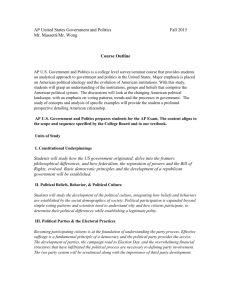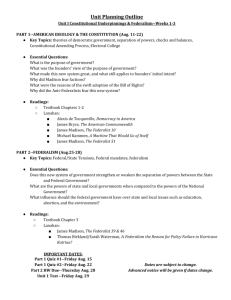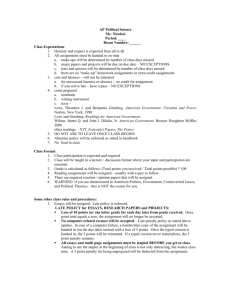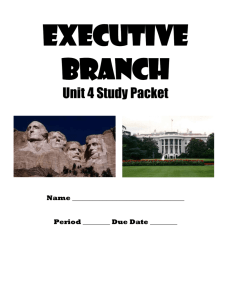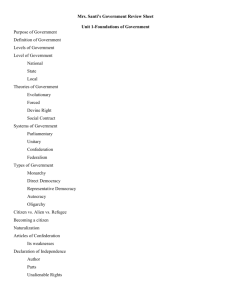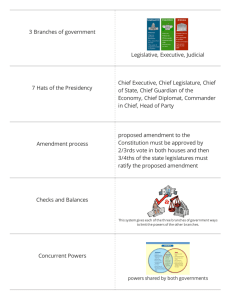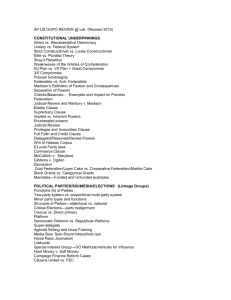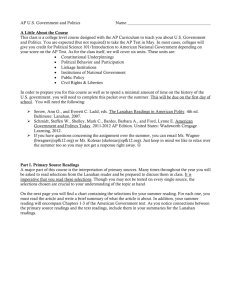AP GOVERNMENT - Public Schools
advertisement
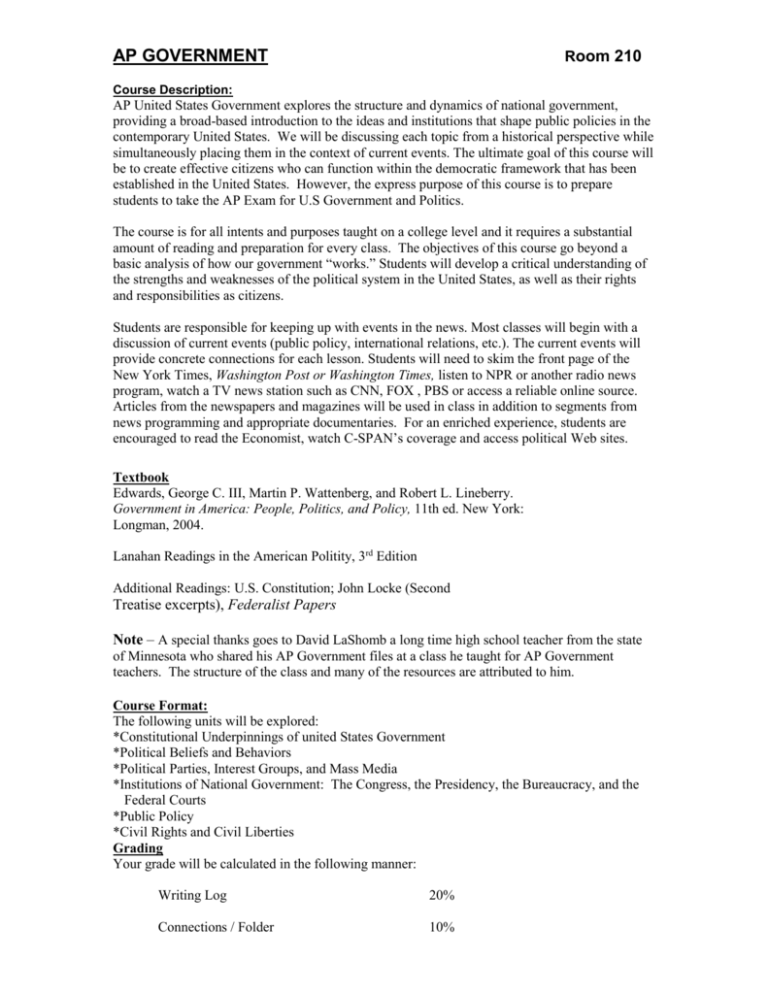
AP GOVERNMENT Room 210 Course Description: AP United States Government explores the structure and dynamics of national government, providing a broad-based introduction to the ideas and institutions that shape public policies in the contemporary United States. We will be discussing each topic from a historical perspective while simultaneously placing them in the context of current events. The ultimate goal of this course will be to create effective citizens who can function within the democratic framework that has been established in the United States. However, the express purpose of this course is to prepare students to take the AP Exam for U.S Government and Politics. The course is for all intents and purposes taught on a college level and it requires a substantial amount of reading and preparation for every class. The objectives of this course go beyond a basic analysis of how our government “works.” Students will develop a critical understanding of the strengths and weaknesses of the political system in the United States, as well as their rights and responsibilities as citizens. Students are responsible for keeping up with events in the news. Most classes will begin with a discussion of current events (public policy, international relations, etc.). The current events will provide concrete connections for each lesson. Students will need to skim the front page of the New York Times, Washington Post or Washington Times, listen to NPR or another radio news program, watch a TV news station such as CNN, FOX , PBS or access a reliable online source. Articles from the newspapers and magazines will be used in class in addition to segments from news programming and appropriate documentaries. For an enriched experience, students are encouraged to read the Economist, watch C-SPAN’s coverage and access political Web sites. Textbook Edwards, George C. III, Martin P. Wattenberg, and Robert L. Lineberry. Government in America: People, Politics, and Policy, 11th ed. New York: Longman, 2004. Lanahan Readings in the American Politity, 3rd Edition Additional Readings: U.S. Constitution; John Locke (Second Treatise excerpts), Federalist Papers Note – A special thanks goes to David LaShomb a long time high school teacher from the state of Minnesota who shared his AP Government files at a class he taught for AP Government teachers. The structure of the class and many of the resources are attributed to him. Course Format: The following units will be explored: *Constitutional Underpinnings of united States Government *Political Beliefs and Behaviors *Political Parties, Interest Groups, and Mass Media *Institutions of National Government: The Congress, the Presidency, the Bureaucracy, and the Federal Courts *Public Policy *Civil Rights and Civil Liberties Grading Your grade will be calculated in the following manner: Writing Log 20% Connections / Folder 10% Projects / Papers / Etc. 10% Attend a local meeting or political function 10% Quizzes 10% Tests 40% Your final percentage total will be rounded to the nearest whole percentage and you will be assigned a letter grade based on the following grading scale: 100-94 93-90 89-88 87-83 A AB+ B 82-80 79-78 77-73 72-70 BC+ C C- 69-68 67-63 62-60 59-0 D+ D DE Each marking period will count as 40% of your semester grade with the semester exam counting as 20%. Writing Log You will write in your writing log 3 to 5 times a week on a topic related to class. Typically, this assignment will revolve around a current event relative to the unit that we are studying. For example, you will analyze political cartoons, graphs and charts. In addition, you will incorporate current data, historical documents, and interpret data from maps. Also, you will analyze select articles and film in your writing log. The writing log is the forum for timed writings where you will answer numerous free–response questions with essays that will develop your ability to analyze and interpret the structure and actors within American government and politics. These essays will prepare you for the essay section of the AP U.S. Government and Politics Exam and for class tests where 25% of the questions are based on historical documents or modern data. Connections / Folder Throughout each unit you must keep track of connections you make between what we are studying in class and current events. When you come across a situation that reminds you of an issue, event, or idea that we have studied in class, write it down or clip it out (your list can include pictures, cartoons, articles from magazines, etc.). You must be explicit in your connections. On each due date, 5 well-explained connections will be submitted for evaluation. Also, you are required to keep all assignments, handouts and “connections” in an orderly folder. Your folders will be turned in at the end of the marking period and awarded points based on content, completeness and order. Projects and Papers Each marking period students will have a project and / or paper. Late Homework and Assignments Any assignment turned in after the due date will be considered late and will be worth a maximum of 50% credit. Any student who misses work or tests due to an absence should consult the website to see what assignments they missed. In many cases, the work can be downloaded directly from my website. If you are absent on the due date, the assignment must be turned in on the day of your return -- if the assignment was made with your knowledge prior to your absence. Otherwise, your grace period will equal the number of days of your excused absence. Special circumstances can be negotiated. Completing assignments and submitting them for evaluation is required for earning credit for the class. Students not completing assignments will receive an “Incomplete” for the class. Students have two weeks after the semester ends to make-up any “Incompletes.” If assignments are not submitted within two weeks the student’s grade will become an “E.” Tests and quizzes must be made-up within two days of the students return to school. Prep Period / Conference Hour I am available from 8:00-8:20 a.m., during my 1st hour prep period, after school or by appointment. Students are welcome to stop by and talk. Students Expectations 1. You are here to learn! 2. Be in your seat, ready to go, when the bell rings. 3. Bring all materials necessary to function in class with you (paper, pen/pencil, folder, writing log, and text). 4. Treat school property and all people in the room with respect. -- No food, pop, Ipods or headphones in the classroom-Student/Teacher Behavior We will respect the feelings, opinions, and efforts of each other. When one person has the floor, everyone in the class will give their undivided attention without undue interruptions. Students should question what they do not understand, and respectfully disagree with points that conflict with their views. The teacher has the responsibility to keep the class moving in a productive manner. Therefore, I will limit discussions that are either inappropriate or are going nowhere. If behavior problems occur, the teacher and students directly involved will discuss the problems, solutions and sanctions at a time and place designated by the teacher. Disciplinary Action If you are asked to leave the room you receive a zero for the day and will be referred to the principal or assistant principal for disciplinary action. This will be considered an absence. Underpinnings of American Government A. OBJECTIVE: The student will understand how the US government originated; delving into the framers philosophical differences, and eventually arriving at how federalism, the separation of powers and the Bill of Rights, evolved. Basic democratic principles and the development of a republican government will be established. The following questions will be addressed: What is the purpose of government? What was the founders’ view of the purpose of government and the role of the citizen in the American Republic? Are these views still relevant at the close of the millennium? How does the constitution underpin U.S. government? The concept of “checks and balances” was a novel idea in the 18th century. Why? How does Madison’s concept of checks and balances challenge popular understanding of Montesquieu’s theory of separation of powers? The following questions will be addressed over federalism: Why did the Anti-Federalists fear this new system? Does this new system strengthen or weaken the concept of separation of powers? Why or why not? What are the powers of state and local governments in an era of “new federalism” and devolution? What influence should the federal government have over state and local issues such as education, affirmative action, abortion, and the environment? B. READINGS: 1. Edwards: pp. 2-24, 26-93, 698-704 2. Lanahan: pp. 59-64; pp. 65-71; pp. 79-86 C. OTHER SELECT MATERIALS: Sections of the Articles of Confederation, the Constitution, and the Federalist Papers; modern commentary on federalism; essay writing rubrics handout. D. Terms and Concepts: 1. Government 3. majority rule 5. pluralist theory 7. hyperpluralism 9. liberals 11. Constitution 12. Articles of Confederation 14. New Jersey Plan 16. Conneticut Compromise 18. Separation of powers 19. republic 21. Anti-Federalists 23. Marbury v. Madison 25. federalism 27. Tenth Amendment 29. Enumerated powers 30. elastic clause 32. full faith + credit 34. fiscal federalism 36. project grant 38. block grants 40. John Locke 42. David Hume 44. C. Wright Mills 46. Devolution E. WRITING LOG 2. democracy 4. minority rights 6. elite + class theory 8. policy gridlock 10. conservatives 12. limited government 13. Shay’s Rebellion 15. Virginia Plan 17. Writ of Habeus Corpus 19. Checks and Balances 20. Federalists 22. Federalist papers 24. Judicial review 26. Supremacy clause 28. McCulloch v. Maryland 29. implied powers 31. Gibbons v. Ogden 33. extradition 35. categorical grants 37. formula grant 39. US v. Lopez 41. Hobbes 43. Richard Hofstadter 45. James Madison 47. politics -- Lanahan Readings During the course of this unit, students will complete the following readings and address the questions in their writing logs. Readings: pp. 59-64 Hofstadter’s “The American Political Tradition” 1. Why did Hofstadter view the founding fathers as selfish and untrustworthy? 2. According to the founding fathers, what was going to control man? 3. What type of government did the founding fathers attempt to develop? 4. Why didn’t the founding fathers attempt to change man? 5. What was the founding fathers’ greatest fear? 6. What three devices were distinguished by a federal Constitution? a. b. c. 7. What did the Fathers mean by liberty? 8. Why was “property” a central issue? 9. Who would “umpire” this strife? Lanahan’s pp. 65-71- Madison’s “The Federalist No. 10” 1.What was Madison’s interpretation of “Faction”? 2. How does Madison attempt to control factions? 3. Why did Madison wish to leave factions alone and attempt to not control them? 4. Describe Madison’s two methods to cure factionalism. a. b. 5. What is at the root of factionalism? 6. In the 1700’s, what provided the breakdown between one faction and another? 7. What is the difference between a democracy and a republic? 8. How did the Constitution, according to Madison, resolve the problem of one government becoming too powerful? 9. What are the remedies to resolving the diseases of a republican government? Lanahan pp. 79-86 C. Wright Mills -- “The Power Elite” 1. Who are the power elite? 2. Are the power elite solitary rulers? 3. What has happened to the decentralized power elites? 4. Why is the military a force to be dealt with? 5. What has brought the three institutions of the power elite together? 6. What type of political organization has the power elite established? 7. Why do the masses accept such control by the power elites? Political Beliefs and Behaviors A. Objective -- Students will understand the development of the political culture, integrating how beliefs and behaviors are established by the social demographics of society. Political participation is expanded beyond simple voting patters and scientists need to understand why citizens participate, and in what context, to determine their political differences while establishing a legitimate polity. This unit will include: 1. Beliefs that citizens hold about their government + its leaders. 2. Processes by which citizens learn about politics. 3. The nature, sources, and consequences of public opinion. 4. The ways in which citizens vote and otherwise participate politically. 5. Factors that influence citizens to differ from one another in terms of political beliefs and behaviors. 6. Interest group development outlining the range of interests, activities, their effects on the political process, and the unique role of PACS. 7. The functions and structures of the mass media as it impacts politics. The following questions will be addressed: How do we come by our political beliefs? What are the sources of public opinion? What is “political culture,” and is there a unique American political culture? What is the “political spectrum”? How do these political beliefs define who we are as citizens? What does it mean to be a citizen? What is the role of the citizen in a civil society? Which citizens vote and why? What is the relationship between individual rights and the needs of the larger community? Is democracy in America healthy and viable today? B. Read: Lineberry pp. L-pp. 172-203, 206-233, 322-350 Lanahan: pp. 86-95, 95-101 C. Terms and Concepts: 1. demography 3. political culture 5. random sampling 7. exit poll 9. media event 11. sound bites 13. liberals 15. conservatives 17. reactionaries 19. Middle of the road 21. elite theory 23. Olson’s law of large groups 25. lobbying 27. PACS 29. push-polling D. WRITING LOG 2. melting pot 4. political socialization 6. random-digit dialing 8. political ideology 10. narrowcasting 12. talking head 14. political spectrum 16. moderates 18. radicals 20. pluralist theory 22. hyperpluralist theory 24.Single issue group 26. electioneering 28. amicus curiae -- Lanahan Readings During the course of this unit, students will complete the following readings and address the questions in their writing logs. pp. 86-95 - Domhoff’s “Diversity in the Power Elite” 1. Who comprises the new diversity? 2. How has this diversity impacted the power elite? 3. Can an Alger become an elite? 4. What were Mills three institutional hierarchies? 5. What is the comfort zone to enter the power elite? 6. Why are women at such a disadvantage? 7. Why were minorities shunned at West Point? 8. How did Colin Powell infiltrate the power elite? 9. What others have joined the power elite? 10. Are they any different from the former power elite? 11. What is the major obstacle to individual fulfillment? 95-101: Dahl’s “ Who Governs, A Preface to Democratic Theory” 1. What is the difference between the political stratum and the apolitical stratum? 2. According to Dahl, how is power distributed in America? 3. Who is holding the political leader captive? 4. Why are relationships between leaders and constituent reciprocal? 5. Who constitutes the political stratum? 6. What are some of the political qualities of the apolitical strata? 7. Can anybody break into the political stratum? How? 8. Why would a political elite deal with certain issues? is this the same self-interest the founding fathers believed in? 9. What comprises the making of governmental decisions? 10 What is at the core of political decision making? Political Parties, Interest Groups, and Mass Media A. Objective -- Becoming participating citizens is at the foundation of students understanding the party process. Effective sufferage is a fundamental principle of a democracy and the political party provides the access. The development of parties, the campaign road to election day and the overwhelming financial structures that have infiltrated the political process are necessary to defining party involvement. The two party system will be scrutinized along with the importance of third party development. This unit will include: 1. The functions, development and organization of political parties. 2. The electoral process. 3. Campaign financing 4. Parties impact on the political process. The following questions will be addressed: Campaigns and Elections: Is this the best system to develop and select leaders? Are citizens well served by the current process? Media: What role do the media play in elections and shaping public opinion? Is the media an impartial observer or an active participant in political elections and in the formation of public policy? Elections: How are candidates selected to run for office? What role is played by party organizations, PACs, and money generally in campaigns? What roles do these groups play in the electoral process? What role should they play? Should the present campaign system be overhauled and reformed? Mass Movement Politics: Political Parties, Interest Groups, and Mass Movement Politics: What is the difference between a Democrat and a Republican? Are there other options beyond these two choices? Political parties and interest groups are not mentioned in the constitution yet they play a critical role. How? Why? Do they serve our democracy or are they an obstacle? How do interest groups influence government decisions and policy making? B. Readings: Edwards: pp. 236-264, 266-320 Lanahan: pp. 611-618 C. Terms and Concepts: 1. Political Party 3. nomination 5. ticket-splitting 7. Patronage 9. closed primaries 11. blanket primaries 13. national convention 15. national chairperson 17. Party dealignment 19. partisan politics 21. Independent party 23. Republican party 24. Winner-take-all system 27. coalition government 29. campaign strategy 31. caucus 33. McGovern Fraser Commission 35. Frontloading 37. Federal Election Campaign Act 39. soft money 41. Buckley v. Valeo 43. 2000 Presidential Election 45. Political efficacy 47. Turnout Bias 49. Electoral College D. WRITING LOG 1 2. Two-party system 4. Rational Choice Theory 6. Party machines 8. Initiative/Referendum 10. open primaries 12. Colorado v. FEC 4. national committee 16. coalition 18. party neutrality 20. third party 22. Democratic party 24. single member plurality 26. Proportional representation 28. gridlock 30. national party convention 32. primaries 34. Superdelegates 36. party platform 38. FEC 40. PACS 42. Selective Perception 44. Sufferage 46. Motor Voter Act 48. Policy Voting 50. Retrospective Voting -- Lanahan Readings During the course of this unit, students will complete the following readings and address the questions in their writing logs. Lanahan pp.611-618: “I Ain’t Got Time to Bleed” 1. Who did Governor Ventura appeal to during his campaign? 2. What word isn’t a part of Governor Ventura’s vocabulary? Has it been true? 3. What is the idea, according to Governor Ventura, that is most distructive? 4. Describe two reasons why Governor Ventura was successful? 5. What major issue did Governor Ventura address? 6. How did Governor Ventura use the media to his advantage? 7. What doesn’t appeal to Governor Ventura concerning his position as governor? Executive Branch/Bureaucracy A. Objective -- The first Constitution neglected this branch, but the second Constitution zeroed in on establishing a leader who would have to work with Congress in perpetuating a democratic society. The President is given few distinctive formal powers , but, over time, has established effective informal powers in managing what has become a huge bureaucracy. As the country has grown, presidential powers have evolved. The student will: 1. explain the formal and informal executive powers. 2. determine how the federal bureaucracy functions. 3. describe how the executive branch fits into the budget development process. 4. describe how the executive branch balances its power with the judicial branch. 5. determine qualities of leadership of a president. B. Readings: Lineberry- pp. 392-427, 471-499. Lanahan--pp. 215-221; pp. 273-279 C. Terms and concepts: 1. Twenty-second Amendment 3. Watergate 5. cabinet 7. Council of Economic Advisors (CEA) 2. impeachment 4. Twenty-fifth Amendment 6. National Security Council 8. Office of Management and Budget 9. veto 11. presidential coattails 13. legislative veto 15. Civil Servants 17. Office of Personnel Management 19. bureaucracy 21. Cabinet Departments 23. FCC 25. SEC 27. Independent executive agencies 29. standard operating procedures 31. regulation 33. command and control policy 35. executive orders 37. Issue Networks D. WRITING LOG 10. pocket veto 12. War Power Resolution 14. crisis 16. patronage 18. Weberian Model 20. Cabinet 22. Independent Regulatory Agency 24. FTC 26. Gov’t Corporations 28. Policy implementation 30. administrative discretion 32. deregulation 34. incentive system 36. iron triangles -- Lanahan Readings During the course of this unit, students will complete the following readings and address the questions in their writing logs. pp. 215-221 “Presidential Power and the Modern President” 1. Why do presidents find leading so frustrating? 2. According to the author, what true powers does the president possess? 3. Are the powers separated or shared with Congress and the Judicial Branch? 4. What advantages does the president have over those two other federal bodies? 5. One of the keys to the power of persuasion is the power to accomplish what mission? 6. Why might presidents look back at the Cold War as an era of stability, authority and glamour? Lanahan readings: pp. 273-279 “. . .A Government of Strangers” 1. What is the purpose of a bureaucrat? 2. Why is the bureaucracy such a mystery? 3. Why does the president find the bureaucracy so frustrating to the implementation of policy? 4. Define Iron Triangle? 5. How can a bureaucrat sabotage his president? 6. How can a president respond to such sabotage? 7. Why is the bureaucracy often referred to as subgovernments? Congress and Appropriation Process A. Objective- Article I of the Constitution delegates formal and informal legislative powers to the halls of Congress. This institution balances its power with the executive and judicial branches of government, an intricate balance that evolves and changes over time. The issue of divided government promotes a process that often can lead from legislative gridlock to true nonpartisanship in dealing with numerous policy issues including how to establish a national budget. The student will: 1. understand the powers of Congress. 2. determine the make-up of the current House and Senate. 3. analyze how Congress and the President undertake the arduous task of developing an annual budget. B. Readings: Edwards- pp. 352-388; pp. 434-464 Lanahan pp: 170-177; pp. 183-185 C. Term and Concepts: 1. incumbents 3. bicameral legislature 5. filibuster 7. majority leader 9. minority leader 11. joint committee 2. pork barrel/log rolling 4. House Rules Committee 6. Speaker of the House 8. whips 10. standing committee 12. conference committees 13. select committees 14. legislative oversight 15. committee chairs 16. seniority system 17. caucus 18. bill 19. budget 20. deficit 21. expenditures 22. revenus 23. income tax 24. Sixteenth Amendment 25. federal debt 26. tax expenditures 27. Social Security Act 28. Medicare 29. incrementalism 30. uncontrollable expenditures 31. entitlements 32. House Ways and Means 33. Senate Finance Committee Committee 35. Congressional Budget and Impoundment Control Act of 1974 36. Congressional Budget Office (CBO) 37. budget resolution 38. authorization bill 39. appropriation bill 40. Shay's Meehan/McCain-Feinhold reform package D. WRITING LOG -- Lanahan Readings During the course of this unit, students will complete the following readings and address the questions in their writing logs. pp. 170-177 “Congressional Women” 1. Is the House of Representatives still seem a “male institution”? 2. What makes the “House” so male? Cite four distinct reasons. 3. How are the women congresspersons dealing with that problem? 4. Are the older or younger male congresspersons the problem? 5. What are some ways to change these sexist attitudes? 6. Are there political liabilities to this insenstitivity? pp. 183-185 “Pork: A Time-Honored Tradition Lives On” 1. Why don’t the voters like “Pork”? 2. Why do Congresspersons like pork? 3. Why is pork seen as waste? 4. Why is pork seen as being beneficial? 5. Is pork waste? Who decides? 6. Are politicians to become selfless angels or smart politicians? Public Policy A. Objective: Public policy is what government accomplishes through its political manuverings. It’s the result of the interactions and dynamics among actors, interests, institutions and processes in the development of domestic and foreign policy. It completes the understanding of how federalism, interest groups, parties and elections are involved in developing policy processes and policy making at the federal level. The student will: 1. investigate policy networks, iron triangles and other forms of subgovernments in the formation of domestic and foreign policy. 2. analyze the role of federal institutions in making policy. 3. Evaluate the link between federal institutions and the citizen in the formation of policy agendas. 4. analyze the role of the citizen in the policy process. 5. analyze policy development in the areas of economics, environment, health care, social welfare and national defense. The following questions will be addressed: Public Policy and the Instruments of National Governance: Bureaucracy: How is public policy made? Does the “system” work as intended? Does the “system” work for citizens today?What are the specific issues addressed in public policy making? Define an“Iron Triangle,” does it exist and if so how does it influence policy implementation? Who controls the bureaucracy: The president? Congress? The people? Does a largely permanent professional bureaucracy serve democracy? Case Studies in Public Policy: Who sets policy agendas for our nation? How does federalism affect public policy? We will examine and debate several areas of public policy. Potential topics include: 1 . The Economy: How is the federal budget made? How is monetary policy different from fiscal policy? What is the “global economy”? How does the global economy influence U.S. policy generally and you specifically? 2. Social Policy: What are subsidies and entitlements? What is the proper role for government in social issues such as education, welfare, and crime? Public Policy and the Institutions of National Governance: Congress: How is public policy made? Does the “system” work as intended? Does the “system” work for citizens today? How does Congress represent and reflect the interest and desires of the nation? Is Congress representative of the nation as a whole? Is this the most efficient and effective way to make policy? Compare and contrast the makeup and operations of the House and Senate. How has Congress’s role in policy formulation changed over time in relation to the other branches? Public Policy and the Institutions of National Governance: Presidency: How is public policy made? Does the “system” work as intended? Does the “system” work for citizens today? What are the formal and informal powers of the presidency? How does the president use these powers to influence policy? Is the president too powerful or not powerful enough vis-a-vis the legislative and judicial branches? Public Policy and the Instruments of National Governance: Judiciary: How is public policy made? Does the “system” work as intended? Does the “system” work for citizens today? What role do the courts play in interpreting the Constitution and implementing public policy? Are the courts “guilty,” as some of critic charge, of supplanting the legislative and executive branches by legislating from the bench? What is the proper role for the judicial branch in the public policy process? What is the evolving relationship between the courts and “civil rights”? B. Reading: pp. 542-562, 564-586, 588-614, 637-654 C. Terms and Concepts: 1. unemployment rate 3. Consumer Price Index 5. Fiscal policy 7. Demand side economics 9. Transnational corporations 11. NLRA 13. right to work laws 15. entitlements 17. income distribution 19. progressive taxes 21. regressive taxes 23. feminization of poverty 2. inflation 4. Monetary policy 6. Federal Reserve System 8. Supply side economics 10. anti-trust policy 12. collective bargaining 14. welfare 16. Means-tested programs 18. poverty line 20. proportional taxes 22. EITC 24. EPA 25. NEPA 26. Clean Air Act of 1970 27. Water Pollution Control Act of ‘72 28. Endangered Species Act of ‘73 29. Global warming 30. Superfund 31. Medicare 32. Medicaid 33. HMO’s 34. Cold War 35. Terrorism 36. EU 37. Interdependency 38. Globalization 39. Monetarism 40. Supply Side economics 41. Demand-side economics Judicial Branch/ Civil Rights/Liberties A. Objective: Article III of the Constitution establishes the judicial branch. One Supreme Court and a number of inferior courts will be analyzed in promoting civil rights and civil liberties through out a diverse community. This branch balances out the democratic principles established by the framers who felt it important to put a device that stabilized the power of the executive and legislative branches. The following questions will be addressed: Civil Liberties and Civil Rights: What constitutes free speech? How does the national Bill of Rights apply to states? Do the courts “legislate from the bench”? 1 . Freedom of Speech, the Press, and Assembly: What forms of speech are protected? How is the 1st Amendment affected in times of crisis? 2. Religion: What constitutes “establishment”? What are the limits of “free exercise”? Civil Liberties and Civil Rights: What is “equal protection” under the law? How does the national Bill of Rights apply to states? Do the courts “legislate from the bench”? 1 . Life, Liberty and Property: What is procedural due process? Is there a right to privacy? What do property rights mean in relation to community interests? 2. Equal Protection and the 14th Amendment: How has the interpretation of the equal protection clause changed over time? How have laws like the Civil Rights Act of 1964, the Voting Rights Act of 1965, and affirmative action influenced our understanding of the clause? Special Assignment—Civil Liberties and Civil Rights Landmark Cases]: Each student is assigned two landmark Supreme Court cases. For each assigned case, the student must prepare a written and oral brief of the case, including the background of the case, points of law, the decision and rationale of the court, and subsequent related cases. B. Readings: Edwards- pp. 504-540; 94-169; Lanahan -- pp. 315-317; 423-427; C. Terms and Concepts: 1. Standing to sue 3. justiciable disputes 5. original jurisdiction 7. districts courts 9. Supreme Court 11. solictor general 13. stare decisis 15. original intent 17. Marbury v. Madison 19. US v. Nixon 21. judicial activism 23. civil liberties 25. First Amendment 27. incorporation doctrine 29. free exercise clause 31. libel 33. probable cause 35. search warrant 37. Fifth Amendment 39. Sixth Amendment 41. Eighth Amendment 43. right to privacy 45. equal protection of the law 47. Civil Rights Act of ‘64 49. poll taxes 51. Ninteenth Amendment 53. comparable worth 55. affirmative action 2. class action suits 4. amicus curiae briefs 6. appellate jurisdiction 8. courts of appeal 10. senatorial courtesy 12. opinion 14. precedent 16. judicial implementation 18. judicial review 20. judicial restraint 22. statutory construction 24. Bill of Rights 26. Fourteenth Amendment 28. establishment clause 30. prior restraint 32. symbolic speech 34. unreasonable search + seizure 36. exclusionary rule 38. self-incrimination 40. plea barganing 42. cruel + unusual punishment 44. civil rights 46. Thirteenth Amendment 48. Fifteenth Amendment 50. Twenty Fourth Amendment 52. ERA 54. American Disability Act D. Lanahan pp. 315--319 -- Alexander Hamilton “The Federalist 78” 1. Define Judicial Review 2. What is the source of power of the Judicial Branch? 3. What major power does the courts hold? 4. How can the courts achieve this power? Cite three principles 5. Who will protect those who face the spirit of the injustice? Lanahan: pp. 423-427: “ Glendon’s Rights talk” 1. What is the “Rights” talk? 2. What has the exchange of ideas about matters of high public important come to a standstill? 3. What “rights” are being abused? 4. Where does the “self” fit into the universe? 5. What has the “rights” dialogue created?

